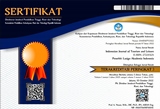Impact of Destination Images and E-WOM on Urban Millenial Decision to Visit Tourism Potential City
Abstract
Tourism potential in Serang City is almost eliminated and forgotten along with the city’s continuous expansion. The role of urban millennials in promoting tourism is now important. Therefore, researchers used urban millennials as respondents in this study. By using SEM analysis with the SmartPLS application, this research was conducted to determine destination image preferences from millennial tourists in Serang City and their influence on e-WOM and the decision to visit. The results indicated support for affective image, price image, and travel motivation positively influence e-WOM. However, e-WOM does not appear to have a significant positive influence on the decision to visit. Additionally, cognitive image is the only factor that positively influences the decision to visit directly. The proposed mediating role of e-WOM in the relationship between destination image with the decision to visit is not supported. The findings of this study offer important factors for the destination marketers, policymakers, and businesses of a potential tourism city, in this case Serang City, to consider when developing a specific marketing strategy for this market segment (urban millennials). In addition, the results of this study provide a better understanding of the urban millennial perspective on their decision to visit cities with tourism potential.
Keywords
Full Text:
PDFReferences
Anzani, R. S., Rahmiati, F., Chairy, C., & Purwanto, P. (2022). The effect of travel risk perception and destination image on visit decision in the new normal. Jurnal Manajemen Dan Pemasaran Jasa, 15(1), 95–110. https://doi.org/10.25105/jmpj.v15i1.10686
Armutcu, B., Tan, A., Amponsah, M., Parida, S., & Ramkissoon, H. (2023). Tourist behaviour: The role of digital marketing and social media. Acta Psychologica, 240. https://doi.org/10.1016/j.actpsy.2023.104025
Badir, M., & Andjarwati, A. L. (2020). The Effect of E-WOM, Ease of Use and Trust on Purchase Decisions (Study on Tokopedia Application Users). Jurnal Minds: Manajemen Ide Dan Inspirasi, 7(1), 39. https://doi.org/10.24252/minds.v7i1.13715
Baloglu, S., & Mccleary, K. W. (1999). A Model of Destination Image Formation. Annals of Tourism Research, 26(4), 868-897. https://doi.org/10.1016/S0160-7383(99)00030-4
Cohen, J. (n.d.). Statistical Power Analysis for the Behavioral Sciences Second Edition.
Hafidzah, N. N., & Hayadi, F. (2024). Ekombis Review-Jurnal Ilmiah Ekonomi dan Bisnis Interest in Revisiting Yogyakarta City Among Generation Z. Ekombis Review: Jurnal Ilmiah Ekonomi Dan Bisnis, 12(1), 12. https://doi.org/10.37676/ekombis.v11i2
Huete Alcocer, N., & López Ruiz, V. R. (2020). The role of destination image in tourist satisfaction: the case of a heritage site. Economic Research-Ekonomska Istrazivanja, 33(1), 2444–2461. https://doi.org/10.1080/1331677X.2019.1654399
Koc, E., & Ayyildiz, A. Y. (2021, November 1). Culture’s influence on the design and delivery of the marketing mix elements in tourism and hospitality. Sustainability (Switzerland), Vol. 13. MDPI. https://doi.org/10.3390/su132111630
Litvin, S. W., Goldsmith, R. E., & Pan, B. (2008). Electronic word-of-mouth in hospitality and tourism management. Tourism Management, 29(3), 458–468. https://doi.org/10.1016/j.tourman.2007.05.011
Lu, A. C. C., & Gursoy, D. (2015). A conceptual model of consumers’ online tourism confusion. International Journal of Contemporary Hospitality Management, 27(6), 1320–1342. https://doi.org/10.1108/IJCHM-04-2014-0171
Nasar Politeknik Negri Kupang, A. (2022). Influence of Electronic Word of Mouth on Destination Image and Their Impact on Visiting Interests and Decisions (A Case Study on Millennial Travelers).
Neuhofer, B., Buhalis, D., & Ladkin, A. (2015). Technology as a Catalyst of Change: Enablers and Barriers of the Tourist Experience and Their Consequences. In Information and Communication Technologies in Tourism 2015 (pp. 789–802). Springer International Publishing. https://doi.org/10.1007/978-3-319-14343-9_57
Reswari, R. A., Ariffin, M., Geneveva, T., & Jesajas, J. (n.d.). Efektivitas E-WOM Dalam Memprediksi Minat Berkunjung Ke Kota Pontianak. https://doi.org/10.51266/borneoakcaya.v9i2.298
Samudro, A., & Hamdan, H. (2021). The Effect of e-WOM, Security and Trust on Purchasing Decisions of Green Lake City Housing. Journal Ilmiah Manajemen Dan Bisnis, 7(3), 312–323.
Slamet, S., Prasetyo, B. P. W., & Azmala, I. (2022). The Impact of Electronic Word of Mouth and Brand Image on Online Purchase Decisions Moderated by Price Discount. European Journal of Business and Management Research, 7(2), 139–148. https://doi.org/10.24018/ejbmr.2022.7.2.1340
Wang, Y., & Herrando, C. (2019). Does privacy assurance on social commerce sites matter to millennials? International Journal of Information Management, 44, 164–177. https://doi.org/10.1016/j.ijinfomgt.2018.10.016
Widyastuti, H., & Putri, Y. S. (2023). The Effect of Electronic Word of Mouth, Destination Image on Tourist Visiting Decisions at Nagari Tuo Pariangan Tourism Object. TIJAB (The International Journal of Applied Business), 7(1), 104–114.
DOI: https://doi.org/10.36256/ijtl.v5i1.394
Refbacks
- There are currently no refbacks.
Copyright (c) 2024 Indonesian Journal of Tourism and Leisure

This work is licensed under a Creative Commons Attribution-NonCommercial-ShareAlike 4.0 International License.
Indonesian Journal of Tourism and Leisure Indexed and Archieved By:

Indonesian Journal of Tourism and Leisure is licensed under a Creative Commons Attribution-NonCommercial-ShareAlike 4.0 International License.













